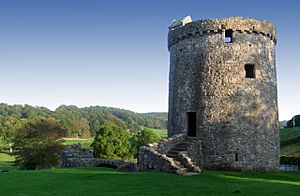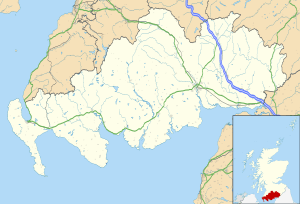Orchardton Tower facts for kids
Orchardton Tower is a very old, ruined building in Kirkcudbrightshire, Dumfries and Galloway, Scotland. It's located about 4 miles (6.1 km) south of Dalbeattie. This tower is unique because it's the only tower house in Scotland that is shaped like a circle. Most other towers from that time were square or rectangular. Orchardton Tower is now looked after by Historic Environment Scotland.
Contents
History of Orchardton Tower
Building the Unique Round Tower
The Cairns family were connected to this area from the early 1400s. A man named John Cairns was given the land of Orchardton in 1456. He built Orchardton Tower soon after this.
What makes Orchardton Tower so special is its round shape. Round towers were popular in the 1200s, but by the 1400s, most new towers were built with square or rectangular shapes. This means Orchardton Tower was built about 200 years after round towers went out of style! Some people wonder if Irish builders influenced its design, as round towers were common in Ireland.
Changes in Ownership
Over the years, the tower and its land changed hands many times. In 1616, the part of Orchardton that included the tower was sold to Robert Maxwell. He was later given the special title of a "baronet" in 1663. A baronet is a British title of honour, similar to a knight, that can be passed down through the family.
The Maxwell family faced challenges, especially during the Protestant Reformation. This was a time when people in Europe were divided over different religious beliefs. One family member, Mungo Maxwell, was unfairly disinherited (meaning he lost his right to inherit property) because of his religion.
His son, Robert Maxwell, grew up in France. He later joined the French Army. Robert returned to Scotland to fight in the Jacobite rising of 1745. This was a rebellion where people tried to put Prince Charles Edward Stuart (Bonnie Prince Charlie) back on the throne. Robert was hurt and captured at the Battle of Culloden. Because he was a foreign soldier, he was treated as a prisoner of war, not a traitor, and was not executed.
A New Home and the Tower's Future
After returning to France, Robert Maxwell decided to claim his family's inheritance. He changed his religion to Protestant and began a long legal fight. In 1771, he finally won and became Sir Robert Maxwell, 7th Baronet. These events even inspired the famous writer Sir Walter Scott for his novel Guy Mannering.
Sir Robert Maxwell then built a new, more comfortable house nearby. He used stones from the old castle that was next to Orchardton Tower. This new house is now called Orchardton Castle. However, Sir Robert ran into financial problems. In 1785, the whole estate was sold to the Douglas family. It's thought that no one lived in Orchardton Tower after this time.
Exploring the Tower
The round tower was part of a larger, fortified area called a barmkin. A barmkin was a strong wall that protected a yard. This yard would have kept animals safe and had other buildings like cellars and a bakehouse. The tower itself was mainly for living in.
The tower is about 11 meters (36 feet) tall and 9 meters (30 feet) wide. Its walls are very thick, about 1.8 meters (6 feet) thick! Inside the tower, the ground floor was a vaulted cellar. A vault is an arched roof, often made of stone. Above this, there was a main room with a fireplace and deep windows that had seats. There was also a carved basin called a lavabo or piscina, which was used for washing hands or sacred vessels. There would have been two more rooms above this, but their wooden floors have fallen down over time.



